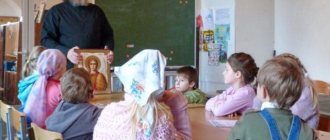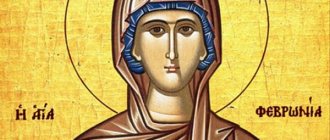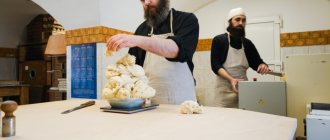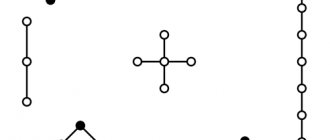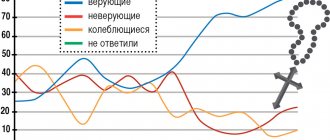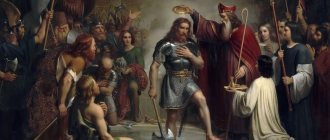About bowing at every divine service[*]
The following signs of the cross without bowing, signs of the cross with bows from the waist, and signs of the cross with bows to the ground should be performed:
- at the initial exclamation of each service - 3 bows from the waist;
- on every Trisagion; “Come, let us worship...”; “Alleluia, alleluia, alleluia, glory to Thee, O God,” - 3 bows;
- exceptions: a) in the first part of Matins, before the Six Psalms, only the signs of the cross without bows are performed; b) on Alleluia (three times), during kathismas on Sundays and holidays, bows are left;
- on “Our Father...” (at the beginning) - bow;
- at the end of “It is worthy to eat...” (or Zadostoynik) - bow;
- when singing, reading troparions, kontakions, stichera, when the words express worship, one must bow;
- at each petition, after all the litanies, there is a bow;
- at every priestly exclamation there is a bow.
What are bows
Bowing in church is the bowing of the body before God during prayer. They are usually performed after making the sign of the cross . During worship, a person bows many times.
Bows happen:
- Belt . A person bends at the waist while bowing from the waist, without bending his knees, touching the floor with his hand. Then he straightens his back. Otherwise called “small”.
- Terrestrial . They are also called “great”. When bowing to the ground, a person falls to his knees, touching his forehead to the floor. Then he gets up and straightens up.
There are different times for making prostrations and bows. On Sundays and church holidays, only bows from the waist are performed; high bows are prohibited. And during Great Lent, the most prostrations are performed, especially during the reading of the prayer of St. Ephraim the Syrian. During the period from Easter to Pentecost one cannot make great bows.
While reading the Six Psalms, it is forbidden to make even small bows; you can only cross yourself. When blessing the priest, you just need to bow your head, but not bow. When blessing with a cross, you must make the sign of the cross and make a small bow.
About bowing during the all-night vigil
At the beginning of the Six Psalms, with the triple “Glory to God in the highest” - 3 signs of the cross (without bowing!);
- in the middle of the six psalms, with three times “Alleluia” - 3 signs of the cross (without bowing!);
- during the polyeleos, during the first and last magnification (which are sung by the clergy in the middle of the temple) - after bowing to the ground;
- to “Glory to Thee, Lord...” before reading the Gospel and after reading - by bowing;
- before kissing the holy Gospel or holy icon - 2 bows;
- after kissing - 1 bow;
- at the canon, with all the choruses of all nine songs - bow;
- at “My soul magnifies the Lord”, at the end of each “Most Honest” - a bow;
- to “Glory to Thee, who showed us the light” before the great doxology - a bow;
- after the great doxology on the Trisagion - 3 bows.
How to bow correctly
Bows must be made correctly, without disturbing others or getting injured. It is worth remembering the saying: “make a fool pray to God...” When making bows from the waist, one must be wary of the possibility of stretching your back. With good sports training, you need to touch the floor with the fingers of your right hand. But if you have back pain, you can just bow a little. If there are a lot of people in the temple, quite crowded, then there is no need to be zealous and hit your head in the back of the person in front. You can simply bow your head without disturbing anyone.
When bowing to the ground, there is a chance of getting a head injury by hitting the floor hard. Here you should act wisely, bow, lightly touching your head to the floor. There is also a chance of damaging your palms, so you need to land on your bent knuckles. It is advisable to place a rug on the floor.
About bowing during the Divine Liturgy
After all litanies, at all petitions, there is a bow; exception: on petitions intended for the prayer of the catechumens, such as: “Pray, catechumen, O Lord” and “Catechumenate, bow your heads to the Lord,” you should not bow;
- at all priestly exclamations - by bow;
- after the small entrance, while singing “Come, let us bow” - bow;
- at the exclamation “For Thou art Holy, our God,” the sign of the cross without bowing;
- to “Lord, save the pious” - bow;
- to the deacon’s exclamation “And forever and ever” - a bow without the sign of the cross;
- on the Trisagion - 3 bows;
- to “Glory to Thee, Lord...” before reading the Gospel and after it - by bowing;
- at the great entrance, when the priest proclaims “You and all Orthodox Christians” - bow without the sign of the cross;
- at the end of the Cherubic Song, while singing “Alleluia” - 3 bows;
- at the beginning of the Creed - the sign of the cross without bowing;
- at the end of the Creed, at “...the tea of the resurrection of the dead...” - bow;
- at the “Mercy of the World”, at each exclamation of the deacon or priest - a bow from the waist;
- when shouting “We thank the Lord”, when singing “It is worthy and righteous to worship...” - bow to the ground;
- at the Lord’s words: “Take, eat...” and “Drink from it all...” - with a deep bow from the waist;
- after the consecration of the Holy Gifts (i.e., before singing “It is Worthy to Eat” or the Zadostoynik) - bow to the ground;
- after “It is worthy to eat” or Zadostoynik – bow;
- on “Our Father”, at the beginning - a bow to the ground;
- on “Our Father” at the end (with the words “...deliver us from evil”) - bow;
- at the exclamation “Holy to Holies” - 3 bows or prostration;
- at the first appearance of the Holy Gifts, at the exclamation “With the fear of God...” - bow to the ground;
- after reading the prayer for Communion “I believe, Lord, and confess...”, all communicants, before approaching the Holy Chalice, bow to the ground, and those who do not partake bow to the ground;
- at the second appearance of the Holy Gifts, at the exclamation “Always, now and ever...” all those who did not receive communion bowed to the ground, and those who received communion bowed from the waist;
- When reading the prayer behind the pulpit, stand with your head bowed.
The charter of bowing, handed down from the fathers.
Entering the temple of God, a person finds himself in a special environment - heaven on earth. Everything here has harmony and spiritual beauty and meaning. Everything is in its special place, its order and order are maintained - there is no chaos or disorder here. The icons are arranged in a certain order, the singing is performed according to strict ancient laws, and the prayer is followed by a specific prayer. And only in the ranks of those praying will an outsider not be able to notice harmony and order. There is no need to talk about our walks around the temple, or conversations during the service. But even in small things - in the appropriate and meaningful sign of the cross and bow, we do not have unity. But a pilgrim is as much a participant in the service as a priest, as is a singer. The Holy Church requires bowing with inner reverence and outer decorum, slowly, and, if possible, simultaneously with other worshippers, namely when indicated.
We want to talk about the regulations on bowing, especially since many people were interested in this, embarrassed by modern ignorance and complete arbitrariness in this matter. In different sources one can now find inconsistency with each other and even contradictions. We will take as a basis the experience of the famous researcher and zealot of the Church Rule - bishop and confessor Afanasy (Sakharov) (F 1962).
First of all, let's talk about what worries almost everyone - about prostrations to the ground - when it is appropriate to perform them and when not. Prostrations to the ground during divine services are performed at a certain time (as, indeed, bows), and not at will. They are appropriate for days of repentance - everyday ones and, especially, fast days. But on holidays: on great holidays, on Sundays, prostrations to the ground are completely canceled, according to the establishment of the Holy Fathers. Also, during the periods from Easter to Trinity Day (Pentecost) and from Christmas to Epiphany (Holytide), prostrations are not required. For example, canon 90 of the VI Ecumenical Council says: “ From our God-bearing Fathers it was canonically handed down to us: not to bend the knee on Sundays, for the sake of the honor of the Resurrection of Christ
" With all this, bows from the waist (small) are not made arbitrarily, but at certain moments, in accordance with the meaning of the prayers.
At any worship service the following is required:
- when reading or singing "Come, let's worship
", "
Holy God
", three times "
Hallelujah
", "
Blessed be the name of the Lord
" - three bows from the waist; - on "Blessed art thou, Lord, teach me by thy justification.
"—three bows from the waist;
- at all litanies, making the sign of the cross while singing “Lord have mercy
” or “
Give me, Lord
,” make a bow; - On stichera and other prayers, bowing is only required when the words of the prayers encourage this, for example: “let's fall down
", "
we bow down
", "
we pray
"; - before and after reading the Gospel (on “Glory to You, Lord
") a bow from the waist is always required;
- when reading the akathist, on each kontakion and ikos there is a bow from the waist, and on the 13th kontakion, which is read three times, a bow from the waist or from the ground, depending on the day;
- at the end of service, after "The most honest Cherub
” and before “
Bless the Name of the Lord, Father
” - a deep bow from the waist; - when the clergyman teaches peace by saying "Peace to all
”or the like, and the choir answers: “
And to your spirit
” - a bow from the waist
without the sign of the cross
; - at the words "Bow your heads to the Lord
"- bow your head without the sign of the cross until the end of the prayer, but do not bow;
- when overshadowed by the Cross, the Holy Gospel or an icon - a small bow with the sign of the cross;
- when overshadowing with candles, when blessing with the hand or when censing the upcoming censers - a bow without the sign of the cross (only on Easter when censing with the Cross, in response to the greeting "Christ is Risen
" - they answer, crossing themselves: “
Truly he is risen
"); - when reading or singing the psalms of the Prophet King David, no bows are required;
- on holidays, when blessing with the hand - bow without the sign of the cross, when blessing with the cross - bow with the sign of the cross.
Unpious self-indulgence is when the laity, with the general blessing of the clergyman, fold their palms, and then, sometimes, also press them to themselves or kiss them.
At Vespers and Matins, as well as at the All-Night Vigil:
- at vespers of Sunday or holiday all-night vigil after prayer "Vouchsafe, Lord
» prostrations stop until Vespers the next day;
- among the six psalms on the triple "Hallelujah
" - the sign of the cross without bowing for each "
Hallelujah
", for the sake of deep silence; - at Matins, when singing the magnification, bow after each magnification;
- while singing "We praise, bless, bow and exalt Thee to all ages.
"- bow from the waist;
- while singing "The most honest Cherub
": after the exclamation “
Let us exalt the Mother of God and the Mother of Light in songs
” - a bow or bow to the ground (depending on the day); - at non-festive matins after "Worthy to eat...
- bow to the ground.
It is necessary to single out two situations that have developed in our parish.
Firstly, this is the behavior of our neighbors - the sister nuns - at services. Some are embarrassed by the way they bow, others imitate them blindly, not knowing the rules. Monks have their own special monastic rules and follow them exactly, but we should neither condemn them nor mindlessly imitate them. Let us adhere to the statute handed down by the Holy Fathers for the entire Church and through this we will gradually learn a little about the meaning of worship.
Secondly - this is a tradition that has become established over time in our church - when the rector censes the entire church, the parishioners move first to one side of the temple, then to the other. In this case, all the attention of the worshipers is diverted from what is being sung or read, and is switched only to the passing clergyman. This, of course, shows respect for the priest and the sacred action, but movement, noise, turning sideways and even with one’s back to the altar, distraction from prayer are in no way consistent with the structure of the service. Therefore this tradition has no basis. During such censing, the person praying must step back and let the priest pass, and after that immediately take his place, returning his thoughts to the service. If a priest incenses on people, then one must bow and return to the service, and not accompany him with his gaze throughout the entire rite.
Perhaps this list will seem tedious to someone to memorize, but nevertheless it can help one get used to following the services if a person takes it seriously and diligently follows the instructions of the holy fathers.
* * *
Also, while standing, we pray together on Saturdays (i.e. on Sunday), but we don’t all know the reason for this. For not only, as those who have been resurrected with Christ and obligated to seek the things above, by standing during prayers on the day of resurrection we remind ourselves of the grace given to us, but we also do this because this day is an image of the future age... And so the Church thoroughly teaches her pupils who are in perform this day of prayer while standing, so that, with frequent reminders of endless life, we do not neglect the instructions for this transition... Church statutes teach us to prefer in these days the upright position of the body during prayer, with a clear reminder, as if relocating our thoughts from the present to the future. With every kneeling and rising, we show by action both that we fell to earth through sin, and that, through the love of the One who created us, we were called back to heaven.
(St. Basil the Great, rule 91)
In addition to these bows, there are also the following:
When shouting “Peace to all” or “Grace of our Lord Jesus Christ...”, when the priest blesses the people, bow your head, without the sign of the cross;
- when leaving without the Cross - bow your head, without the sign of the cross;
- when reading the Gospel - stand with your head bowed;
- when censing - respond to the censer with a bow, without the sign of the cross;
- when shouting “Bow your heads to the Lord,” bow your head;
- when leaving with the Cross - bow with the sign of the cross;
- when overshadowing those praying with the Cross, Gospel, icon or Chalice - bow with the sign of the cross;
- when overshadowing those praying with candles or with a hand - a bow without the sign of the cross.
Note:
[*] The rules about prostrations do not apply to Sundays. Read more: On the inadmissibility of prostrations on Sundays.
The text is based on the publication: Patriarchal Orthodox Calendar. Instructions of the Holy Fathers on prayer. 2008. Author-compiler E.Yu. Head Publishing Council of the Russian Orthodox Church, 2007. February 5–9.
What do bows mean?
We bow during prayer, showing our reverence for the Creator. The body is not separated from the soul. Therefore, by bowing, a person expresses his humility and obedience. Bowing with soul and spirit before God, a person does the same with his body. Pride does not like bowing , the holy fathers said.
But on Sundays and holidays, parishioners should not bow to the ground, but stand upright in prayer, personifying the future eternal life. After the resurrection of the dead, believers will be sons of God and not slaves. Saint Basil the Great spoke about this .
Saint Anthony Khrapovitsky said that prostration represents the fall and rise of the human soul. When we fall to our knees, it shows the fall, humility. And when we then get up, it means rebellion, repentance , correction. Therefore, in church it is not customary to kneel for a long time; this is not an Orthodox custom. You have to fall to your knees and then get up.
Priest Andrei Lobashinsky says the same thing: sin brings a person to his knees, but repentance then restores him. God forgives him and makes him His son. This characterizes the spiritual freedom of a person.
